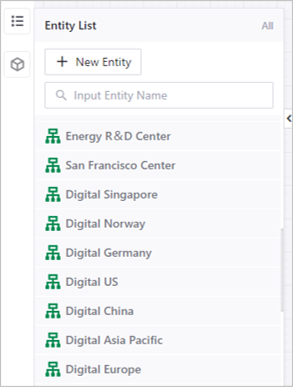Setting Up the Emission Entity¶
This section shows how to add, edit and delete entities to construct an organization’s emission data hierarchy.
Prerequisites¶
Contact your system administrator if your account does not meet the below requirements:
Ensure that you have registered a personal or business account with EnOS to access the EnOS Management Console.
Ensure that your account has a super admin or view admin role.
Ensure that the assets have been added to the current OU.
Creating an Entity¶
Creating your organization emission structure begins with creating a root entity. There can only be one root entity in each view. As the first entity and topmost unit of the emission hierarchy, root entity should either represent the parent company of your business group or the business entity unit which you are tracking the total emissions of. Typical examples of business entity units include regional offices, suppliers, business partners, or subsidiaries.
Following are the steps to create a new root entity:
Click on Data Management > Organization in the left navigation pane. In the view tab, click on the view you have created, then click Configuration in the toolbar to enter the editor dashboard.
Select the entity list button
 and click on the mini arrow
and click on the mini arrow  in the left sidebar to expand the entity list library sidebar menu.
in the left sidebar to expand the entity list library sidebar menu.
Select + New Entity to add a new entity.
Select Entity Type.
If the entity is not a linked IoT asset, select Default.
If the entity is a linked IoT asset, then select IoT.
Asset Tree: Select the asset tree the entity belongs to.
Asset: Select the asset the entity corresponds to.
Entity ID: The asset ID will be displayed automatically.
Note
The entity type cannot be changed once the entity is created.
Enter the Entity Name, this field supports internationalization.
Select OK and the entity will be displayed at the top of the entity list.
The new entity for your organization has been created, and you can now proceed to create a new view using this entity as the root entity in creating a view. You can create new entities to be added as child entities in the same manner.
Editing and Deleting the Entity¶
Select the entity list button
 and click on the mini arrow
and click on the mini arrow  in the left sidebar to expand the hidden entity list sidebar menu.
in the left sidebar to expand the hidden entity list sidebar menu.Hover over the entity you wish to edit to reveal the edit and delete buttons.

Note
An entity can be deleted only if no view is using it.
Click on Edit or Delete to make necessary changes.
Managing Child Entities¶
After creating the root entity as the organization’s uppermost hierarchy layer, you can expand the organization’s emission structure by adding new emission sources as child entities, which can be added to the root entity or other child entities that are connected to the root entity. Typical examples of emission sources include factories, sites, stores, or other facilities within the organization that produce emissions.
Prerequisites¶
Ensure that your account has an administrator role. Contact your system administrator if your account does not meet this requirement.
Ensure that the entity has been added to the entity list.
Adding the Child Entity¶
You must first create new entities in the entity list library (left sidebar) in order to repurpose them as child entities on the dashboard. Once you have created new entities, follow these steps to create a child entity:
Select Configuration in the upper right toolbar to enter editor’s view.
Select the more button
 on the entity card that you want to add a child entity to.
on the entity card that you want to add a child entity to.Select Add Child Entity.
Select one or more entities in the entity list as the child entity of the selected entity.
Select OK, and the child entity will be added to the selected entity in the dashboard.
Deleting the Child Entity¶
To delete a child entity, click the more button  on the entity card, and click on the delete button
on the entity card, and click on the delete button  that appears.
that appears.
Note
The root entity cannot be deleted.
When an entity is deleted, all child entities connected to that entity will also be deleted.